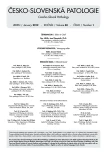Gynaecological precanceroses from the clinical perspective – today and tomorrow
Authors:
Lukáš Rob 1
; Helena Robová 1
; Roman Chmel 1
; P. Škapa 2
Authors‘ workplace:
Gynekologicko porodnická klinika UK 2. LF Praha a FN Motol
1; Ústav patologie a molekulární medicíny UK 2. LF Praha a FN Motol
2
Published in:
Čes.-slov. Patol., 48, 2012, No. 1, p. 9-14
Category:
Reviews Article
Overview
During the last twenty-five years an enormous shift in our knowledge of cancerogenesis in all gynaecological precancerous and cancerous diseases can be seen. Early diagnosis of these lesions of the lower genital tract (vulva, vagina and cervix) is enabled mainly due to easy access. The major role in the pathogenesis of most precancerous lesions can be accounted to high risk human papillomavirus. Recently, new information about HPV genotypisation of single precancerous lesions and single histological cancer types were revealed. Thus we can better estimate the effect of vaccines on different age groups of women in relation to different types of cancer. The development and introduction of prophylactic vaccines into clinical practice was one of the major improvements of current medicine. Precancerous and cancer lesions of endometrium make themselves known by early symptoms such as perimenopausal and postmenopausal bleeding. Optimal diagnostic and therapeutic procedures have to be based on close cooperation between the clinician and pathologist.
Keywords:
precancerosis – HPV – genotyping – screening – prophylactic vaccination
Sources
1. Van Beurden M, ten Kate FW, Tjong AH et al. Human papillomavirus DNA in multicentric vulvar intraepithelial neoplasia. Int J Gynecol Pathol 1998; 17: 12–16.
2. Van de Nieuwenhof HP, van der Avoort IA, de Hullu JA. Review of squamous premalignant vulvar lesion. Crit Rev Oncol Hematol 2008; 68: 131–156.
3. Škapa P, Zámečník J, Hamšíková E et al. Human papillomavirus (HPV) profiles of vulvar lesions: possible implications for the classification of vulvar squamous cell carcinoma precursors and for the efficacy of prophylactic HPV vaccination. Am J Surg Pathol 2007; 31: 1834–1843.
4. Ferlay J, Shin HR, Bray F, et al. Estimates of worldwide burden of cancer in 2008: GLOBOCAN 2008; Int J Cancer 2010; 127: 2893–2917.
5. Munoz N, Bosch FX, de Sanjose S, et al. Epidemiologic classification of human papillomavirus types associated with cervical cancer. N Engl J Med 2003; 348: 518–527.
6. Smith JS, Lindsay L, Hoots B, et al. Human papillomavirus type distribution in invasive cervical cancer and high grade cervical lesions: a meta-analysis update. Int J Cancer 2007; 121: 621–632.
7. Schiffman M, Kjaer SK. Chapter 2: Natural history of anogenital human papillomavirus infection and neoplasia. J Natl Cancer Inst Monogr 2003; 31: 14–19.
8. Koshiol J, Lindsay L, Pimenta JM, et al. Persistent human papillomavirus infection and cervical neoplasia: a systematic review and meta-analysis. Am J Epidemiol 2008; 168: 123–137.
9. Bosch FX, Burchel AN, Schiffman M, et al. Epidemiology and natural history of infections and type-specific implications in cervical neoplasia. Vaccine 2008; 26: Suppl 10: 1–16.
10. Rob L, Robová H, Kačírek J, Pluta M. Prekancerózy děložního hrdla – management abnormálních nálezů na děložním hrdle. Modern Gynekol Porod 2003; 12: 665–675.
11. Robova H, Rob L, Pluta et al. Squamous intraepithelial lesion – microinvasive carcinoma of the cervix during pregnancy. Eur J Gynaecol Oncol 2005; 26: 611–614.
12. Schiffman M, Castle PE, Jeronimo J, et al. Human papillomavirus and cervical cancer. Lancet 2007; 370: 890–907.
13. de Sanjose S, Quint WG, Alemany L, et al. Human papillomavirus genotype attribution in invasive cervical cancer: a retrospective cross-sectional worldvide study. Lancet Oncol 2010; 11: 1048–1056.
14. EMEA. Cervarix summary of product characteristicsEMEA/H/C/ 721II/1711.Available at:http://ec.europa.eu/health/documents/ community-register/html/h419.htm. Accessed 15 September 2010.
15. Huh WK, Paavonen J, Naud P, et al. For the Patricia study group. Efficasy of the HPV-16/18AS04-adjuvanted vaccine in women according to their initial DNA and serostatus: PATRICIA end-of-study results. IGCS 2010; Abstract.
16. Arbyn M, Kyrgiou M, Simoens c, et al. Perinatal mortality and other severe adverse pregnancy outcomes associated with treatment of cervical intraepithelial neoplasia: meta-analysis. BMJ 2008; 337: 1284–1290.
17. Kyrgiou M, Koliopoulos G, Martin-Hirch P, et al. Obstetric outcomes after conservative treatment for intraepithelial or early invasive cervical lesions: systematic review and meta-analysis. Lancet 2006; 367: 486–498.
18. EMEA. Gardasil summary of product characteristics EMEA/H/C/ 703/II/26. Available at: http://ec.europa.eu/health/documents/community-register/html/h357.htm Accessed 15 September 2010.
19. Munos N, Manalastas R, Pitisuttithum P, et al. Safety, immunogenicity, and efficacy of quadrivalent human papillomavirus (types 6, 11, 16, 18) recombinant vaccine in women aged 24-25 years: a randomised, double-blind trial. Lancet 2009; 373: 1949–1957.
20. Einstein MH, Baron M, Levin MJ, et al. Comparison of the immunogenicity and safety of Cervarix TM and Gardasil® human papillomavirus (HPV) cervical cancer vaccines in healthy women aged 18–45 years. Hum Vaccin 2009; 5: 705–719.
21. Mutter GL, Kauderer J, Baak JPA, Alberts DA. Biopsy histomorphometry predicts uterine myoinvasion by endometrial carcinoma: A Gynecologic Oncology Group Study. Hum Pathol 2008; 39: 866–874.
22. Merisio C, Berretta R, De IA et al. Endometrial cancer in patients with preoperative diagnosis of atypical endometrial hyperplasia. Eur J Obstet Gynecol Reprod Biol 2005; 122(1): 107–111.
23. Reed SD, Newton KM, Garcia RL et al. Complex hyperplasia with and without atypia: clinical outcome and implications of progestin therapy. Obstet Gynecol 2010; 116: 365–375.
24. Semere LG, Ko E, Johnson NR et al. Endometrial intraepithelial neoplasia clinical correlates and outcomes: A practice-based experience. Obstet Gynecol 2011; 118: 255–263.
Labels
Anatomical pathology Forensic medical examiner ToxicologyArticle was published in
Czecho-Slovak Pathology

2012 Issue 1
Most read in this issue
- Gynaecological precanceroses from the clinical perspective – today and tomorrow
- Review of precancerous vulvar lesions
- What is new in cervical precanceroses cytodiagnostics?
- Precanceroses of the endometrium, fallopian tube and ovary: a review of current conception
